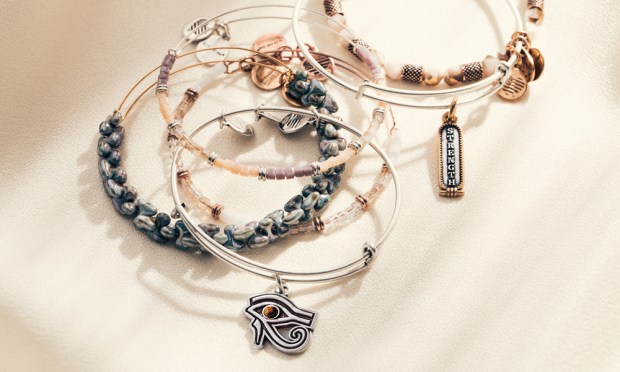For Alex And Ani, Omnichannel Consistency ‘Doesn’t Mean Uniformity’

Selling products through one channel can be hard enough. Selling them through multiple channels can quickly turn into a real headache, one with which jewelry and accessory retailer Alex and Ani is familiar.
The company has grown rapidly since its founding in 2004, beginning as a small Rhode Island-based startup and becoming one of the most popular jewelers in the U.S. market. In fact, it brought in more than $500 million in 2016 alone, and did so on the backs of sales across that wide range of channels.
Alex and Ani sells its bracelets, necklaces, other jewelry and accessories through 109 brick-and-mortar stores, its website and a host of third-party sellers — including online warehouses like Amazon, department stores like Nordstrom and jewelry stores in malls across the U.S. It is also working to provide customers with consistent offerings and messaging across various shopping options.
In a recent interview with PYMNTS, Katherine Bahamonde Monasebian, head of marketing and eCommerce at Alex and Ani, noted that making different options work together doesn’t mean expecting or wanting all its sales channels to function in the same way.
“We want consistency but, from our perspective, that doesn’t mean uniformity,” Monasebian said. “It doesn’t mean that what works on one channel will work on all channels, or that something that works in brick-and-mortar will work for digital. It’s not about being the same — it’s about creating that seamless experience for customers.”
Different methods for success
Jewelry is an inherently difficult business to bring to online shoppers. Shopping for such items is often best done in person, or at least many consumers believe as much.
Monasebian said Alex and Ani is aware of this tendency and, as a result, works to optimize the products it provides via various channels. For instance, the company doesn’t offer the same products, promotional offers or messaging to in-store, online and mobile shoppers. Instead, it tailors its offerings to what each channel does best.
“We’ve noticed that products that are more about building a set or putting together a collection of different pieces [do well] in store [but] don’t do as well on the web,” she said. “We also noticed that products with a lot of detail, whether it’s the facets of a crystal or the texture of a piece, tend to appear flatter on the web.”
Because different products perform better on certain channels than others, Alex and Ani offers a range of limited edition or exclusive products to help encourage consumers to buy from certain channels, according to Monasebian.
Expanding with speed and scale
Today, the company has a well-tested strategy for fusing digital and brick-and-mortar channels to guide its operations. Back when Alex and Ani first hit the scene, however, eCommerce was only just beginning to become the force it is now.
“As much as everyone is talking and reading about these seismic shifts in retail, I really don’t think it can be overstated how the internet has [impacted] — and still is impacting — the retail space,” Monasebian said.
While the company is barely more than a decade old, Alex and Ani competes with players that have been around for decades. That includes industry giants like the Zale Corporation, which was founded in 1924 and currently operates nearly 1,000 jewelry stores in the U.S., and Tiffany and Co., the New York-based jeweler founded in 1837 — nearly 200 years ago.
Nonetheless, Alex and Ani believes it has come of age in step with the rise in digital shopping, Monasebian said, adding that she and her team have seen the shift toward digital commerce firsthand. As a result, the firm has worked to ensure its omnichannel strategy would allow it to grow quickly and without being dragged down by existing infrastructure.
“We grew very fast, and that can be a challenge, because it means you have to be able to grow more quickly with legacy systems, with organization, with technology [and] with our sales team,” she said. “So, we’ve been really focused on trying to set the foundation and work on the fundamentals of omnichannel, and being able to continue to do so, increasingly, at scale.”
Monasebian expects online and mobile sales channels’ influence to grow, and that omnichannel strategies and initiatives will become more important in the coming months and years. To keep pace, Alex and Ani is planning to expand digital initiatives like its “Blueprint” jewelry personalization program. The company is also working to bridge the gap between in-store and online purchases with video and 3-D images of its products.
Ultimately, the goal is to offer an experience that banks on each channel’s strengths to deliver a consistent offering. Though offerings may be consistent, they certainly won’t be uniform, Monasebian said. That’s because just as each diamond is unique, no two sales channels are exactly alike, either.
About the Index
The PYMNTS.com Omni Usage Index, powered by Vantiv (now Worldpay), is designed to measure consumer satisfaction with both in-store and online omnichannel features. The Index gauges the experiences of more than 3,000 consumers shopping at 400 stores, including 22 large merchant chains, small retail stores and online retail outlets. Its analysis combines online purchasing data with our survey data to build out the scale of consumer satisfaction.

